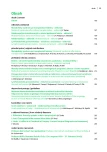Methods of economic analysis of screening programs. Situation in Czech Republic.
Authors:
Jana Bartáková; Jan Jiskra
Authors‘ workplace:
III. interní klinika 1. LF UK a VFN Praha, přednosta prof. MUDr. Štěpán Svačina, DrSc., MBA
Published in:
Vnitř Lék 2014; 60(3): 212-215
Category:
Reviews
Overview
In the process of reducing health budget the question of the effectiveness of investment in population-based screening programs is very actual. Because of the scope, screening is becoming very expensive and burdens healthy people. An essential part of any screening program is careful consideration, registration and monitoring of the results. Here economic analysis are irreplaceable. They enable an objective assessment of the effectiveness of the use of resources and thus become an important basis for decision-making about the allocation of scarce resources for improving the health status of the population. The present text deals with the basic types of economic analysis, including their significance and possibilities when making decisions about recommended screening procedures in the Czech Republic.
Key words:
cost-effectiveness analysis – economic analysis – health care costs – screening
Sources
1. Russell LB. Is Prevention Better Than Cure? Brookings Inst Press: Washington, D.C. 1986. ISBN 10: 0815776314 / ISBN 13: 9780815776314.
2. Doležal T. Význam farmakoekonomického hodnocení. In: Základy farmakoekonomiky pro lékaře, lékárníky a další pracovníky ve zdravotnictví. ČFES: Praha 2007. ISBN 978–80–254–0837–7.
3. Drummond MF, Sculpher MJ, Torrance GW et al. Methods for the Economic Evaluation of Health Care Programmes. Oxford University Press: Oxford (UK) 2005. 3rd ed. ISBN 10: 0198529457 | ISBN-13: 978–0198529453.
4. Greegor DH. Detection of silent colon cancer in routine examination. CA Cancer J Clin. 1969;19(6): 330–337.
5. Neuhauser D, Lewicki AM. What Do We Gain from the Sixth Stool Guaiac? N Engl J Med. 1975 ; 293(5): 226–228.
6. Kalager M, Zelen M, Langmark F et al. Effect of Screening Mammography on Breast-Cancer Mortality in Norway. N Engl J Med. 2010; 363(13) :1203–1210.
7. Bleyer A, Welch HG. Effect of three decades of screening mammography on breast-cancer incidence. N Engl J Med. 2012; 367(21): 1998–2005.
8. Williams A. The cost-benefit approach. Br Med Bull 1974; 30(3): 252–256.
9. Drummond MF, Jefferson TO. Guidelines for authors and peer reviewers of economic submissions to the BMJ. The BMJ Economic Evaluation Working Party. BMJ 1996; 313(7052): 275–283.
10. Brent RJ. Cost-Benefit Analysis and Health Care Evaluations. Edward Elgar Publishing Ltd: Cheltenham, UK; Northhampton, MA 2004. ISBN 10: 184376508X/ ISBN 13: 9781843765080.
11. Brown J, Buxton M. The economic perspective. Br Med Bull. 1998;54(4):993–1009.
12. Zerbe RO, Dively D. Benefit-cost analysis in theory and practice: Harper Collins College Publishers: New York 1994. ISBN 0–673–18066–2.
13. Doležal T, Říhová B, Demlová R et al. Principy farmakoekonomického hodnocení – světové trendy a česká realita. Postgraduální medicína 2011; 13(8): 825–827.
14. Hájek P. Hranice ochoty platit (willingness to pay) – kam směřujeme v ČR? Farmakoekonomika 2012; 6(1): 7–8.
15. Mortimer D, Segal L. Comparing the incomparable? A systematic review of competing techniques for converting descriptive measures of health status into QALY-weights. Med Decis Making. 2008; 28(1): 66–89.
16. Scheunemann LP, White DB. The ethics and reality of rationing in medicine. Chest 2011; 140(6): 1625–1632.
Labels
Diabetology Endocrinology Internal medicineArticle was published in
Internal Medicine

2014 Issue 3
Most read in this issue
- Crush syndrome of today – rhabdomyolysis of intoxicateds
- Pain in chronic pancreatitis and pancreatic cancer – treatment options
- Lymphomatoid granulomatosis – the past and present
- Pathogenesis of inner environment changes in acute muscular compartment syndrome
